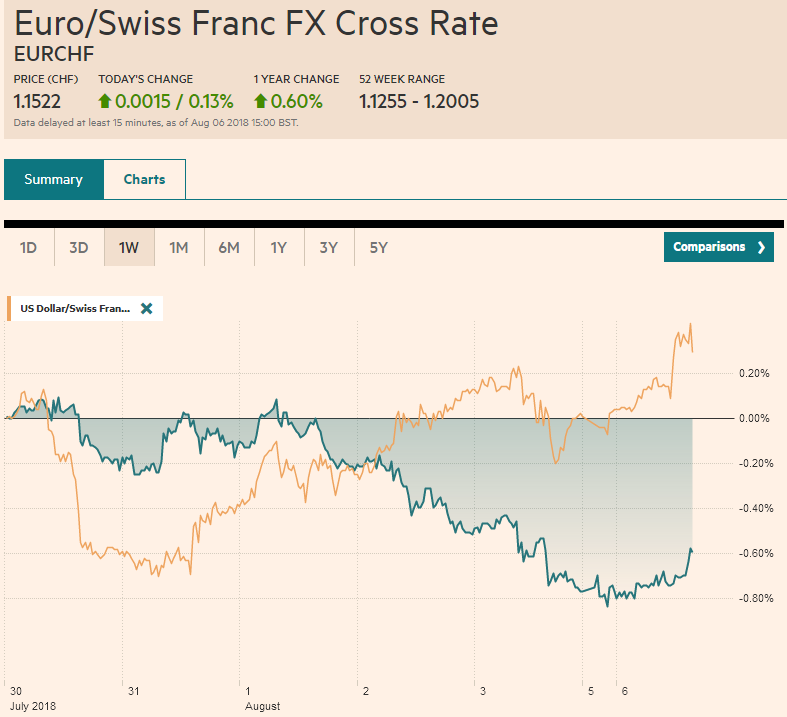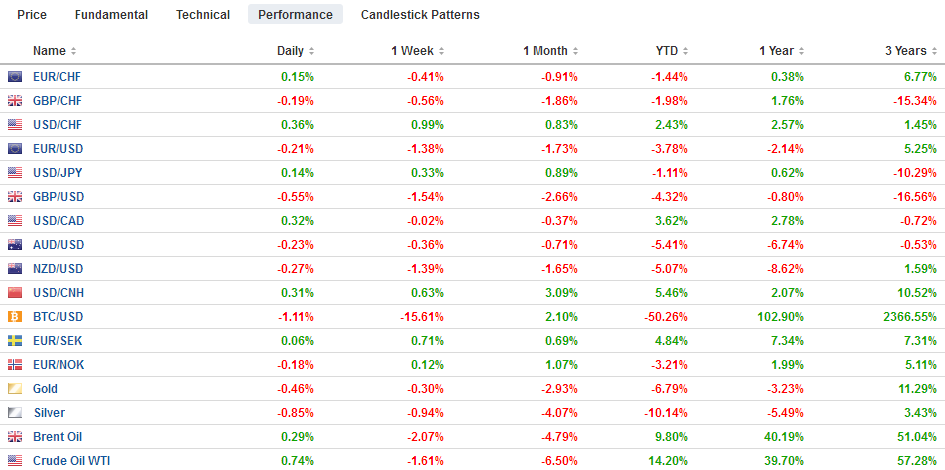Swiss Franc The Euro has risen by 0.13% to 1.1522 CHF. EUR/CHF and USD/CHF, August 06(see more posts on EUR/CHF, USD/CHF, ) Source: markets.ft.com - Click to enlarge FX Rates The US dollar edged higher against most of the major currencies, and emerging market currencies are heavier. Sterling’s quarter percent drop makes it the weakest of the majors in slow turnover and it was sufficient to record a new 11-month low. Sterling failed to get much of a lift from last week’s BOE rate hike, which was widely expected. Carney confirmed that a gradual pace of normalization suggests one hike a year may be appropriate. Carney also acknowledged that the risks that Brexit takes place without a deal were too high for
Topics:
Marc Chandler considers the following as important: $CNY, 4) FX Trends, CAD, EUR, Featured, GBP, JPY, newsletter, USD
This could be interesting, too:
Nachrichten Ticker - www.finanzen.ch writes Die Performance der Kryptowährungen in KW 9: Das hat sich bei Bitcoin, Ether & Co. getan
Nachrichten Ticker - www.finanzen.ch writes Wer verbirgt sich hinter der Ethereum-Technologie?
Martin Hartmann writes Eine Analyse nach den Lehren von Milton Friedman
Marc Chandler writes March 2025 Monthly
Swiss FrancThe Euro has risen by 0.13% to 1.1522 CHF. |
EUR/CHF and USD/CHF, August 06(see more posts on EUR/CHF, USD/CHF, ) Source: markets.ft.com - Click to enlarge |
FX RatesThe US dollar edged higher against most of the major currencies, and emerging market currencies are heavier. Sterling’s quarter percent drop makes it the weakest of the majors in slow turnover and it was sufficient to record a new 11-month low. Sterling failed to get much of a lift from last week’s BOE rate hike, which was widely expected. Carney confirmed that a gradual pace of normalization suggests one hike a year may be appropriate. Carney also acknowledged that the risks that Brexit takes place without a deal were too high for comfort, though not the most likely scenario. The UK’s International Trade Minister Fox took it a step further over the weekend and suggest that such a no-deal Brexit was likely and blamed, of course, the EC’s intransigence. Sterling is testing $1.2950. The next target is near $1.28, which corresponds with a 61.8% retracement of the rally since the flash crash low in October 2016 that Bloomberg puts at $1.1840. The euro, which has its own challenges, is firm against sterling, but below last week’s high near GBP0.8935. The GBP0.8960-GBP0.8970 area has turned it back twice in the past six months. The Italian government fiscal plans, which were such a concern last week have eased today. Italy’s 10- year benchmark yield is off 4.4 bp today, the most in Europe, putting more space between in at the 3.0% threshold. The two-year yield is off nearly seven basis points to slip below 90 bp. There has not been much news to account for the reversal, but the coming clash with the EU may not be for a couple more months. |
FX Performance, August 06 |
Germany
Meanwhile, the surprise of the day comes from Germany. June factory orders dropped a heady 4%–eight-times larger of a decline than the median in the Bloomberg survey forecast, and enough to push the year-over-year rate below zero for the first time in two years -0.8%). Officials cited uncertainty from trade and the silver lining is that since June, the US and EU found a way to lift some of the uncertainty (no new tariffs during new negotiations) without doing anything concrete.
Demand from non-EMU partners fell 5.9%. Capital goods orders fell 4.7% while domestic orders fell 2.8%. Note that Germany factory orders fell five of the six months in H1 and narrative has shifted from transitory factors like the weather, a downshift from strong H2 17 growth, to now trade tensions. Of course, all seem true and the bottom line is slower German growth. It warns of weaker industrial production figures and softer trade numbers, which are reported tomorrow.
The euro extended its slide and is down now for the fifth consecutive session. The loss before the weekend snapped a seven-week run of firmer closes on Friday. It was not that US jobs data was particularly strong. The headline missed, but back month revisions made up the difference. Moreover, almost 32k jobs that were lost in the sports goods, hobbies, and bookstores likely reflected the demise of Toys “R” Us and the nearly 33k employees let go without severance. Earnings edged up but did not accelerate, and at 2.7%, average hourly earnings likely lagged behind headline CPI, which is expected to have risen to 3% in June (released at the end of the week). The jobs data keeps expectations for one and possibly two more hikes this year well in tow.
Today could be the first day this year that the euro does not trade at $1.1600 or better. And there is an option for nearly 600 mln euros struck at $1.1605 that could help cap it. Important technical support is seen in the $1.1500-$1.1510 band. The $1.1450 area corresponds with a 50% retracement of the euro’s recovery from the start of the last year. The 61.8% retracement is near $1.1190.
The Canadian dollar is under modest pressure, though still inside the pre-weekend range. The market’s knee-jerk reaction was to sell it on news of a diplomatic dispute between Canada and Saudi Arabia. Canada’s Foreign Affairs Minister Freeland tweeted in defense of an activist in Saudi Arabia that had been arrested. Saudi Arabia expelled the Canadian ambassador and recalled its envoy. Saudi Arabia said it would suspend trade and investment, which a quick look, suggests a limited relationship in the first place. Today is the sixth session that the US dollar has traded below CAD1.30, but it has only closed once below there and that was barely so before the weekend. On the top side, a cap is being formed near CAD1.3040.
Japan
The Japanese government bond market was stable and the 10-year benchmark yield was unchanged just above nine basis points. The dollar is consolidating in a narrow quarter yen range in the lowe end of the pre-weekend’s outside down day. Initial resistance is seen near JPY111.40-JPY111.60. Japanese shares traded off, with the Topix slipping a bit more than 0.5%, while the Nikkei, edged less than 0.1% lower.
The 20% reserve requirement for yuan forward failed to step the yuan’s depreciation. The US dollar briefly traded above CNY6.85. Before the PBOC announcement at the end of last week, the dollar traded near CNY6.9. Chinese shares also remained under pressure, with Shanghai losing 1.3% and Shenzhen shedding 2.1%. Short-term rates, such as three- and six-month SHIBOR are softer, off five to seven basis points lower. This seems to be offsetting efforts to steady the yuan.
The US and Canadian economic schedule is light. The US and Chinese trade tensions are running high, but the focus today may shift to the implementation of the first round of US sanctions against Iran. European companies that have important business in the US may comply with the embargo. Several large companies have already indicated as much. The oil embargo does not come into effect until November, and reports suggest both China and India stopped up their oil purchases from Iran in July.
Graphs and additional information on Swiss Franc by the snbchf team.
Tags: #GBP,#USD,$CAD,$CNY,$EUR,$JPY,Featured,newsletter

